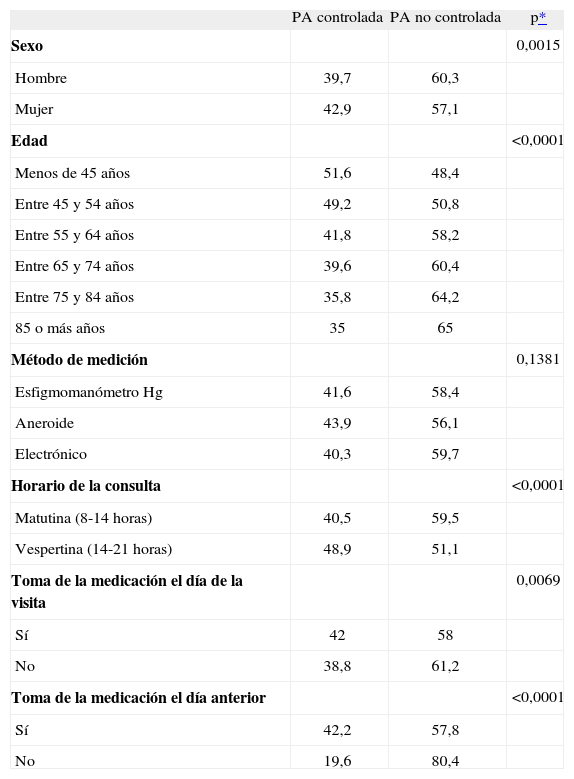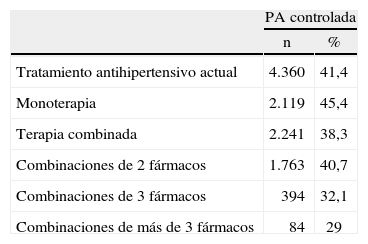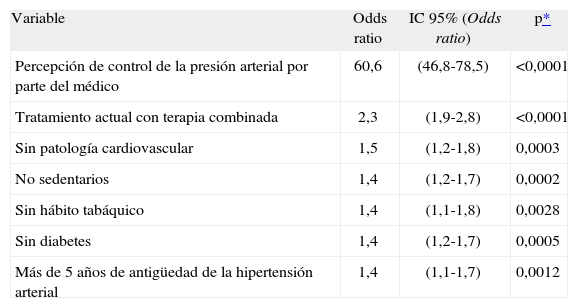Se dispone de poca información sobre la inercia terapéutica en Atención Primaria (AP). El objetivo de este estudio fue conocer la conducta terapéutica del médico de AP en los pacientes hipertensos mal controlados.
Pacientes y métodosEstudio transversal y multicéntrico que incluyó a pacientes hipertensos de ambos sexos, tratados farmacológicamente, que fueron reclutados consecutivamente en consultas de AP de toda España. Se registraron datos sociodemográficos, clínicos y del tratamiento, así como los motivos de modificación terapéutica cuando se produjeron. Se consideró buen control cuando el promedio era inferior a 140/90mmHg en general, y menor de 130/80mmHg en pacientes con diabetes, insuficiencia renal o enfermedad cardiovascular.
ResultadosSe incluyó a 10.520 pacientes (53,7% mujeres), con una edad media de 64,6 (11,3) años, tratados con monoterapia el 44,4% y con terapia combinada el 55,6% (41,2% dos fármacos, 11,7% tres y 2,8% más de tres). El 58,6% [intervalo de confianza (IC) 95%: 57,6-59,5] presentó mal control de la presión arterial (PA). El médico modificó el tratamiento en el 30,4% (IC 95%: 29,2-31,6) de los sujetos mal controlados, siendo las conductas más frecuentes la combinación con otro fármaco (46,3%), el incremento de dosis (26,1%) y la sustitución del antihipertensivo (22,8%). La percepción de buen control de la PA por parte del médico mostró una mayor probabilidad de no modificar el tratamiento farmacológico.
ConclusionesLos resultados del estudio indican que el médico de AP modifica la pauta terapéutica antihipertensiva establecida en tan sólo tres de cada diez pacientes mal controlados. En los casos en los que se modifica el tratamiento, la asociación farmacológica es la conducta más frecuente.
There is little information available on Therapeutic Inertia in Primary Care (PC). This study aimed to know the therapeutic behavior of the physician for uncontrolled hypertensive patients.
Patients and methodsCross-sectional, multicenter study that included hypertensive patients of both genders, under pharmacological treatment who were recruited consecutively in the PC out-patient clinic in all of Spain. Social-demographic, clinical and treatment data were recorded, as well as the motives for eventual therapeutic modification. Adequate BP control was considered when BP values were below 140/90 mmHg in general, and below 130/80mmHg in diabetes, renal insufficiency or cardiovascular disease.
ResultsA total of 10,520 patients (53.7% women) were included with average age of 64.6 (11.3 years). Of these, 44.4% the patients were receiving monotherapy and 55.6% were treated with combined therapy (two drugs 41.2%, three drugs 11.7%, and more than three 2.8%). Uncontrolled hypertension was found in 58.6% (95% CI. 57.6-59.5) of the patients. Treatment was modified by physicians in 30.4% (95% CI. 29.2-31.6) of the uncontrolled patients, combination with another drug being the most frequent behavior (46.3%), followed by dose increase (26.1%), and antihypertensive drug switch (22.8%). The perception of the physician of good BP control was the factor most associated with not modifying the treatment in uncontrolled patients.
ConclusionsStudy results showed that the PC physician modified antihypertensive treatment in only 3 out of 10 uncontrolled patients. When treatment modification was made, association of drugs was the most frequent behavior.
Artículo
Diríjase desde aquí a la web de la >>>FESEMI<<< e inicie sesión mediante el formulario que se encuentra en la barra superior, pulsando sobre el candado.

Una vez autentificado, en la misma web de FESEMI, en el menú superior, elija la opción deseada.

>>>FESEMI<<<











